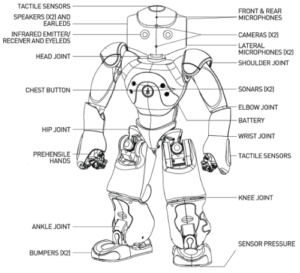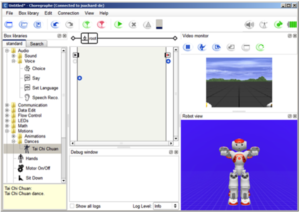The Nao robot has many sensors and joints that when manipulated can produce an autonomous driver for the vehicle in this project. There are two infrared receiver/emitter sensors located on each of the Nao’s eyes, which allow the robot to relay information taken directly from the environment to the microcontroller. Additionally, the Nao has a USB port in the back of his head, which allows for the input of information from the microcontroller.
The Nao has a program for coding called Choregraphe. It’s user-friendly interface makes it simple to develop more complex coding programs. In the figure below the different windows of Choregraphe are shown. On the far left is the Box libraries panel, which includes elementary boxes needed to develop behaviors for the Nao. The center panel, Flow Diagram Panel, is the main board for developing and running the behaviors. A small triangular figure in the upper left-hand corner marks the onStart input of the Flow Diagram. From there a wire is connected to whichever box you choose to place in the panel. Dragging a box into the Flow Diagram Panel and connecting the wires from start to onStopped output on the opposite side will allow that behavior to be performed by the Nao currently connected to the network. The far right hand side is the robot view, which displays a 3D model with the current positions of each joint of the robot. It is here where the joint angles and positions can be adjusted to certain degrees.


